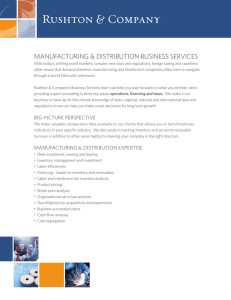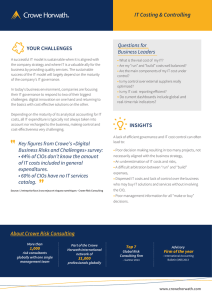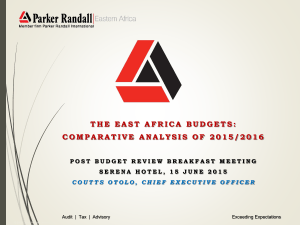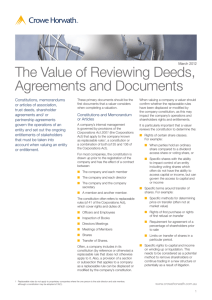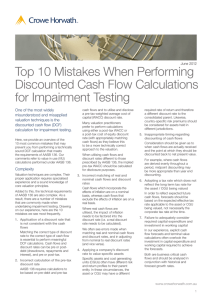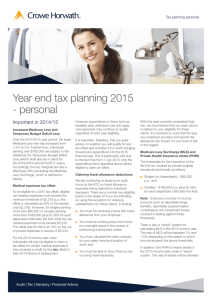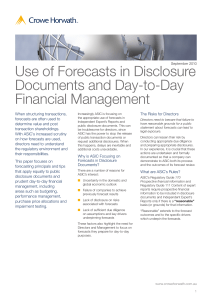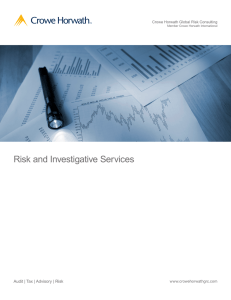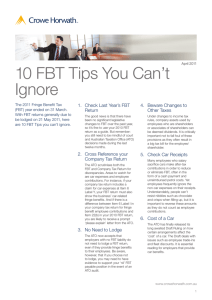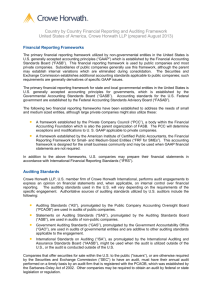How to “cut the clutter” in your financial statements
advertisement
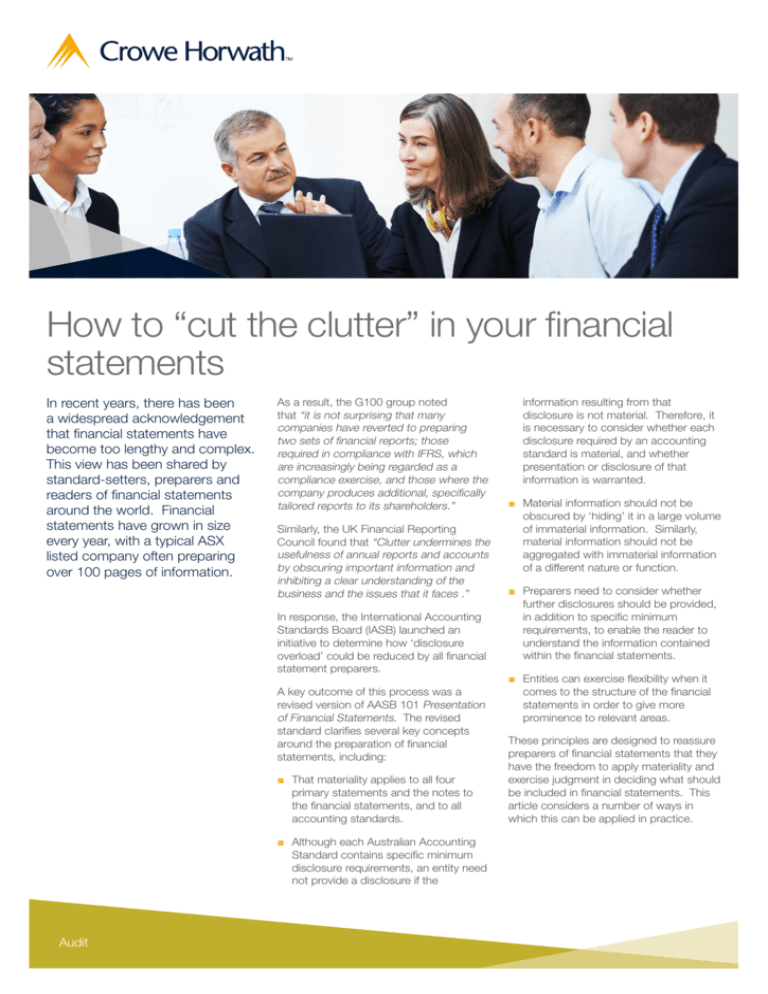
. . How to “cut the clutter” in your financial statements In recent years, there has been a widespread acknowledgement that financial statements have become too lengthy and complex. This view has been shared by standard-setters, preparers and readers of financial statements around the world. Financial statements have grown in size every year, with a typical ASX listed company often preparing over 100 pages of information. As a result, the G100 group noted that “it is not surprising that many companies have reverted to preparing two sets of financial reports; those required in compliance with IFRS, which are increasingly being regarded as a compliance exercise, and those where the company produces additional, specifically tailored reports to its shareholders.” Similarly, the UK Financial Reporting Council found that “Clutter undermines the usefulness of annual reports and accounts by obscuring important information and inhibiting a clear understanding of the business and the issues that it faces .” In response, the International Accounting Standards Board (IASB) launched an initiative to determine how ‘disclosure overload’ could be reduced by all financial statement preparers. A key outcome of this process was a revised version of AASB 101 Presentation of Financial Statements. The revised standard clarifies several key concepts around the preparation of financial statements, including: ■■ That materiality applies to all four primary statements and the notes to the financial statements, and to all accounting standards. information resulting from that disclosure is not material. Therefore, it is necessary to consider whether each disclosure required by an accounting standard is material, and whether presentation or disclosure of that information is warranted. ■■ Material information should not be obscured by ‘hiding’ it in a large volume of immaterial information. Similarly, material information should not be aggregated with immaterial information of a different nature or function. ■■ Preparers need to consider whether further disclosures should be provided, in addition to specific minimum requirements, to enable the reader to understand the information contained within the financial statements. ■■ Entities can exercise flexibility when it comes to the structure of the financial statements in order to give more prominence to relevant areas. These principles are designed to reassure preparers of financial statements that they have the freedom to apply materiality and exercise judgment in deciding what should be included in financial statements. This article considers a number of ways in which this can be applied in practice. ■■ Although each Australian Accounting Standard contains specific minimum disclosure requirements, an entity need not provide a disclosure if the Audit . . . 1. Focus on Materiality 2. Change the order 3. Use plain English The revised AASB 101 confirms that the concept of materiality applies to disclosures just as much as to the numbers themselves. This presents several opportunities for reducing the volume of disclosure in the notes to the financial statements: A typical set of financial statements consists of the primary statements, followed by multiple pages of accounting policies (usually in Note 1), with numerical disclosures further back. These notes often appear in the same order that the related items appear in the balance sheet and income statement. The use of technical language and accounting jargon is a common complaint by readers of financial statements, particularly when describing accounting policies. Preparers can take action to reduce this problem: ■■ Some balances are frequently immaterial or ‘small’ in the context of the financial statements, but have extensive disclosure requirements. These disclosures can be rolled back. Areas to focus on could include: ■■ Share based payments – is it necessary to include a detailed description of every tranche of option issued? ■■ Financial instruments – are all the risk and liquidity disclosures relevant to the users of the financial statements? ■■ Property plant and equipment – is it necessary to make extensive use of tables showing detailed movements of relatively small amounts. ■■ Likewise, a material balance in the Statement of Financial Position does not mean that all disclosures relating to it are material. For example, preparers might ask themselves whether a note on prepayments provides any further useful information to the reader. Preparers should remember that materiality is determined by understanding what information would be relevant and useful to the readers of financial statements, rather than only considering an arbitrary size threshold. Why are they presented this way when Australian Accounting Standards do not mandate any order for notes? The reason is no more than “that’s the way we’ve always done it.” The contents of Note 1 are rarely important enough to justify such a prominent position. They usually consist of densely written and technically worded descriptions of accounting policies, augmented by detailed descriptions of standards which have not yet been adopted and may not be for several years. In order to simplify the structure of the financial statements, preparers should consider the following: ■■ Notes in financial statements should be re-ordered so as to group similar items together. For example, notes on receivables, loans, capital management and financial instruments are often widely separated, even though the information within them can overlap and is more relevant when considered together. ■■ Those disclosures of greatest interest to investors and other users should be presented first. ■■ A description of only the significant accounting policies should be included, while others might be removed altogether. This information may be better presented as part of the related note, rather than in Note 1. ■■ Disclosures included for compliance purposes, rather than for information, should be towards the end of the report (or removed entirely). ■■ Reconsider whether all accounting policies are necessary, particularly if they relate to transactions that did not occur in the current or prior year. ■■ If a policy is simply a copy of the wording from the accounting standard, then it adds no value to the user and could be removed or updated to be entity-specific. ■■ Are you asking yourself if all Board members understand the accounts without further explanation? If not, then the readers will also likely struggle. 4. Change approach Preparers should start to incrementally move towards ‘de-cluttering’ by changing their approach to drafting the financial statements. As an initial approach, this may include: ■■ Limiting the reliance placed on ‘model’ financial statements for accounts preparation. Using model financial statements that are not entity-specific will often result in the preparation of disclosures that use ‘boiler-plate’ language, without giving a genuine insight into the business. ■■ Moving away from using a checklistbased approach, to assessing disclosure completeness. Rather than asking whether all the boxes have been ticked, preparers should be focussing on the messages they are trying to convey, and whether there is anything else that they think investors or other users would like to know. Audit . . . Case Study: Bega Cheese A comparison of the Bega Cheese Ltd financial statements between 2013 and 2015 shows a successful application of the de-cluttering principles above. In particular: ■■ The notes to the financial statements have been re-ordered with the accounting policies section moved from first to last, ■■ Notes were grouped together around common themes based on plain English descriptions (e.g.. “How numbers are calculated”), and ■■ The total volume of note disclosures has been reduced from 40 to 26 pages by removing immaterial and unnecessary disclosures. ■■ A comparison of the index from the 2013 and 2015 financial statements shows the effect of the changes made. Source: Bega Cheese Limited Annual Reports 2015 and 2013 Bega Cheese Ltd Financial Statements Bega Cheese Ltd Financial Statements Year Ended 30 June 2013 Year Ended 30 June 2015 Consolidated Statement of Comprehensive Income Consolidated Balance Sheet Consolidated Statement of Changes in Equity Consolidated Statement of Cash Flows Notes to the Financial Statements 1 Summary of Significant Accounting Policies 2 Financial Risk Management 3 Critical Accounting Estimates and Judgements 4 Segment Information 5 Revenue 6 Expenses 7 Income Tax 8 Current Assets - Trade and Other Receivables 9 Current Assets - Other Financial Assets 10 Current Assets - Inventories 11 Non-Current Assets - Other Financial Assets 12 Non-Current Assets - Property, Plant and Equipment 13 Non-Current Assets - Intangible Assets 14 Current Liabilities - Trade and Other Payables 15 Current Liabilities - Borrowings 16 Current Liabilities - Derivative Financial Instruments 17 Current Liabilities - Provisions 18 Non-Current Liabilities - Derivative Financial Instruments 19 Non-Current Liabilities - Borrowings 20 Non-Current Liabilities - Provisions 21 Share Capital 22 Reserves 23 Dividends to Shareholders 24 Remuneration of Auditors 25 Contingent Liabilities, Guarantees and Warranties 26 Commitments 27 Related Party Transactions 28 Subsidiary and Joint Venture 29 Closed Group Disclosure 30 Notes to the Consolidated Statement of Cash Flows 31 Earnings Per Share 32 Share Based Payments 33 Parent Entity Financial Information 34 Reclassification of items in Consolidated Statement of Comprehensive Income 35 Subsequent Event 34 35 36 37 38 38 48 54 54 57 57 58 60 60 60 61 61 62 63 63 63 63 64 64 64 65 67 67 68 68 68 69 72 73 74 75 75 77 78 78 Consolidated Statement of Comprehensive Income Consolidated Balance Sheet Consolidated Statement of Changes in Equity Consolidated Statement of Cash Flows How Numbers Are Calculated 1 Significant Events in the Accounting Period 2 Segment Information 3 Earnings Per Share 4 Dividends to Shareholders 5 Revenue and Other Income 6 Expenses 7 Income Tax 8 Trade and Other Receivables 9 Derivative Financial Instruments 10 Inventories 11 Property, Plant and Equipment 12 Intangible Assets 13 Trade and Other Payables 14 Borrowings 15 Derivative Financial Instruments 16 Provisions 17 Share Capital 18 Reserves 19 Notes to the Consolidated Statement of Cash Flows Risk 20 Critical Accounting Estimates and Judgements 21 Financial Risk Management 22 Capital Risk Management Group Structure 23 Parent Entity Financial Information 24 Subsidiary and Joint Venture 25 Closed Group Disclosure Unrecognised Items 26 Contingent Liabilities, Guarantees and Warranties 27 Commitments 28 Subsequent Event Other Information 29 Related Party Transactions 30 Remuneration of Auditors 31 Share-Based Payments 32 Reclassification of Other Items 33 Summary of Significant Accounting Policies 38 39 40 41 42 43 45 46 46 47 48 50 51 51 51 52 53 53 53 54 54 55 56 57 57 63 63 64 64 65 65 65 66 67 67 68 68 Audit . . Talk to one of our advisors Please contact your local Crowe Horwath advisor to find out how we can assist you. Connect with us: @CroweHorwath_AU Crowe Horwath Australia How can Crowe Horwath assist you? Crowe Horwath can help you to improve the presentation of your financial statements and build efficiency into your year-end reporting process by: ■■ Reviewing your current financial statements and identifying areas where opportunities exist for de-cluttering, ■■ Benchmarking your current financial statements against current best practice, ■■ Providing guidance to finance teams or to Audit Committees, and ■■ Assisting with drafting and preparation of financial statements. Please contact your local Crowe Horwath representative for further details. i ii Group of 100 – Less is More UK FRC – Cutting Clutter – Combating clutter in annual reports About Crowe Horwath Crowe Horwath Australasia is the largest provider of practical accounting, audit, tax, business and financial advice to individuals and businesses from a comprehensive network of over 100 offices. Tel 1300 856 065 Crowe Horwath is part of a global accounting network that delivers high quality audit, tax and advisory services in over 100 countries. We are the relationship that you can count on – large enough to offer a range of expertise and skills – and small enough to provide the personal touch. www.crowehorwath.com.au The relationship you can count on Crowe Horwath (Aust) Pty Ltd | ABN 84 006 466 351. Date: February 2016 Crowe Horwath (Aust) Pty Ltd has exercised reasonable care in preparing this content but accepts no liability, under any theory of liability, including but not limited to in tort, in contract, under statute or in equity, for any loss sustained by any person as a result of relying on any advice contained herein. All information, opinions, conclusions, forecasts or recommendations are current at the time of compilation but are subject to change without notice. Crowe Horwath (Aust) Pty Ltd assumes no obligation to update this content after it has been issued. This information has been prepared without taking into account your objectives, financial situation or needs, and therefore you should consider if the information suits your needs before making a decision. Crowe Horwath (Aust) Pty Ltd is a member of Crowe Horwath International, a Swiss verein. Each member firm of Crowe Horwath is a separate and independent legal entity. Crowe Horwath (Aust) Pty Ltd and its affiliates are not responsible or liable for any acts or omissions of Crowe Horwath or any other member of Crowe Horwath and specifically disclaim any and all responsibility or liability for acts or omissions of Crowe Horwath or any other Crowe Horwath member. .
